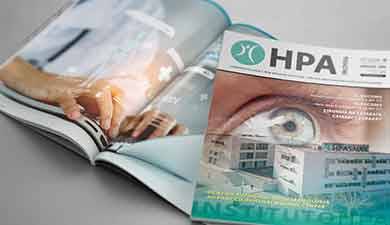Dr. Luís Dores
Otolaryngologist

Drª. Lígia Pires
Pulmonologist

Sudden deafness and hyperbaric medicine
HPA Magazine 6
Sudden Sensorineural Hearing Loss is acute hearing loss. There are various causes, although in the majority of cases it is idiopathic (no known cause).
It is usually unilateral and the prognosis depends on the severity of the hearing loss. It is considered to be an urgent situation, for which treatment should begin in the first 48 hours after the symptoms start. One of the therapeutic possibilities is oxygen therapy in a hyperbaric chamber.

I’VE LOST MY HEARING; DO I HAVE SUDDEN
SENSORINEURAL HEARING LOSS?
Hearing loss is a common problem that everyone experiences from time to time. Most commonly it occurs when flying or traveling up a mountain, and a full sensation develops in the ears, leading to the feeling of wanting to pop the ears open in order to hear better. Diminished hearing also may occur during an ear infection. These causes of hearing loss are usually short-lived. The other extreme is the permanent hearing loss that occurs with aging.
WHY HAVE I SUDDENLY LOST MY HEARING?
When evaluating the cause, your doctor will question you and evaluate the structures in the ear, which is divided into three segments: the outer ear, comprising the auricle and ear canal; the middle ear, comprising the tympanic membrane, the ossicles, and the middle ear space; and the inner ear, comprising the cochlea, semicircular canals, and internal auditory canals. There are multiple pathologies that can present as hearing loss, the main causes are:
Outer Ear
Infections: They may lead to blockage of the external ear canal due to the accumulation of debris, edema, or inflammation. Otitis externa usually develops as a result of local trauma and contamination after swimming, showering, or exposure to hot humid conditions. The most common symptoms are otalgia (earache), pruritus, discharge, and hearing loss.
Cerumen: Some patients are not able to clear cerumen (ear wax) on their own or use cotton swabs that push the cerumen down the ear canal. These individuals may need periodic cleaning of the cerumen to enhance their auditory capabilities. This is more common in patients with oily skin or known dermatologic diseases as eczema.
Middle Ear
Auditory tube dysfunction: The auditive tube connects the nasopharynx (back of the nose) with the middle ear. Auditive tube dysfunction occurs commonly in the setting of a viral upper respiratory infection or sinusitis, and it can also occur with allergies. Patients have the feeling of ear fullness and hearing loss that can persist for up to 6 weeks.
Infection: Otitis media is a common childhood disorder that also frequently occurs in adults. Otitis media is normally associated with pain, fever, and ear fullness as well as decreased hearing. This occurs because fluid filling the middle ear space prevents the TM from vibrating adequately. In this case treatment will involve the use of antibiotics. As in auditive tube dysfunction the fluid resolves within four to six weeks in 70 percent of cases.
Tympanic membrane perforation: Can be caused by many events, including blast injury, barotrauma (diving), foreign body trauma, temporal bone fractures, ear infections, self-inflicted trauma from a Q-tip or other object. After an acute perforation, the ear needs to be examined under the microscope to ensure that no other complications occur and the auditory status should be obtained. Perforations can heal on their own but occasionally surgical correction is required.
Inner Ear
Presbycusis: Presbycusis, or age-related hearing loss, is a common cause of hearing loss worldwide. The hallmark of presbycusis is the progressive, symmetric loss of high frequency hearing over many years in an elderly individual. Common complaints associated with it include the inability to understand speech in a crowded or noisy environment and difficulty understanding consonants. Tinnitus is often present. Is this cases Hearing aids can benefit most patients
Meniere’s Disease: Patients with Meniere’s Disease complain of episodic spells of vertigo, associated with aural fullness, tinnitus, and sensorineural hearing loss. The spells of hearing loss may occur on a daily, weekly, or monthly basis. This chronic disease can cause serious impact in the quality of life, multiple vertigo incapacitating episodes and severe hearing loss through time.
Noise exposure: Everyday noise exposure, compounded over time, has an impact on our ability to hear. Jobs associated with excessive noise can ultimately affect the degree of the hearing loss that develops. A short blast of loud noise also can cause severe hearing loss and pain. Thus, hearing protection in the form of muffs or plugs is highly recommended anytime a person is exposed to loud noise.
WHAT IS SUDDEN SENSORINEURAL HEARING LOSS (SSNHL)?
SSNHL is an infrequently cause of hearing loss. It involves an acute unexplained hearing loss, nearly always unilateral, that occurs over less than a 72-hour period. Although we know that it occurs at the Inner Ear, most cases are idiopathic (no known cause), and the prognosis depends on the severity of the presenting hearing loss.
Patients should seek emergency ENT/Otolaryngology evaluation. Your doctor will exclude all common causes of sudden hearing loss and perform examination of the ear under the microscope. Your auditory status should be evaluated by clinical procedures or by hearing study (audiometry).
Patients with suspected SSNHL should be imaged with contrast MRI, whenever possible. This can be performed during the 6 months after the diagnosis. Most of the time the problem will not be identifiable by MRI. However, other serious causes of unilateral hearing loss involving the peripheral or central nervous system may only be discovered on an MRI scan.

I HAVE SUDDEN SENSORIAL HEARING LOSS! AND NOW?
SSNHL can be treated, but the response to treatment is associated with various factors. Normally young patients, who present with light symptoms, moderate hearing loss and no co-morbidities, will have better hearing recovery scores. According to recent studies, approximately two-thirds of patients with SSNHL will experience recovery, although this recovery is often not complete
Treatment should begin as soon as possible, pre-
ferably in the first 48 hours after the first symptoms. Glucocorticoids are considered first-line therapy and may be administered systemically (generally orally) or locally via intratympanic installation. Intratympanic glucocorticoids are often reserved for use when hearing does not improve after a trial of systemic therapy or in patients with contraindications. Recent clinical guidelines published by the American Academy of Otolaryngology recommend hyperbaric oxygen therapy within 3 months of diagnosis, for patients who do not recover from their hearing loss completely.
WHAT IS THE ROLE OF HYPERBARIC OXYGEN THERAPY IN THE TREATMENT OF SSHL?
The most recent guidelines published by the American Academy of Otolaryngology, as well the European Committee for Hyperbaric Medicine, recommend treatment with hyperbaric oxygen (HBOT).
This is a treatment entailing inhalation of 100% oxygen with ambient pressure higher than atmospheric pressure (the air we usually breathe has 21% oxygen). In order to create these conditions, hyperbaric chambers, which are watertight compartments resistant to high pressures, are used (figure 1).
Under these conditions, the arterial pressure of oxygen is increased, which causes an equal increase in the amount of oxygen dissolved in the plasma (around 22 times at a pressure of 2 absolute atmospheres) and the increase of transport of oxygen to the tissues and its redistribution, having effects on the tissues that are subject to hypoxia (lack of oxygen). The vascular compromise and the decrease of oxygen in the hearing part of the inner ear (the cochlea) are the final route of the mechanisms that lead to the loss of hearing in sudden sensorineural hearing loss.
HBOT is recommended for those patients who do not completely recuperate their hearing after 2 weeks of treatment with corticoids. However, if the evolution of the disease is longer than 3 months, the efficiency of the HBOT is limited. The patients who show the greatest benefit are those who have a moderate to severe loss of hearing and patients under 60 years of age.
The risk of adverse effects is low; the most frequent difficulty is for the patient to equalise the middle ear, which can lead to barotrauma (perforation of the tympanic membrane), so instruction and a pressurisation test are given before admitting the patient to undergo the sessions.
On average, 10 sessions of 100 minutes each are recommended, once a day, 5 days a week. The hyperbaric chamber at the Hospital in Alvor is a multiple chamber with 8 places. During the routine sessions, the patients are accompanied by a nurse, who is always inside the chamber, and are also supervised by a technician and doctor outside the chamber.








